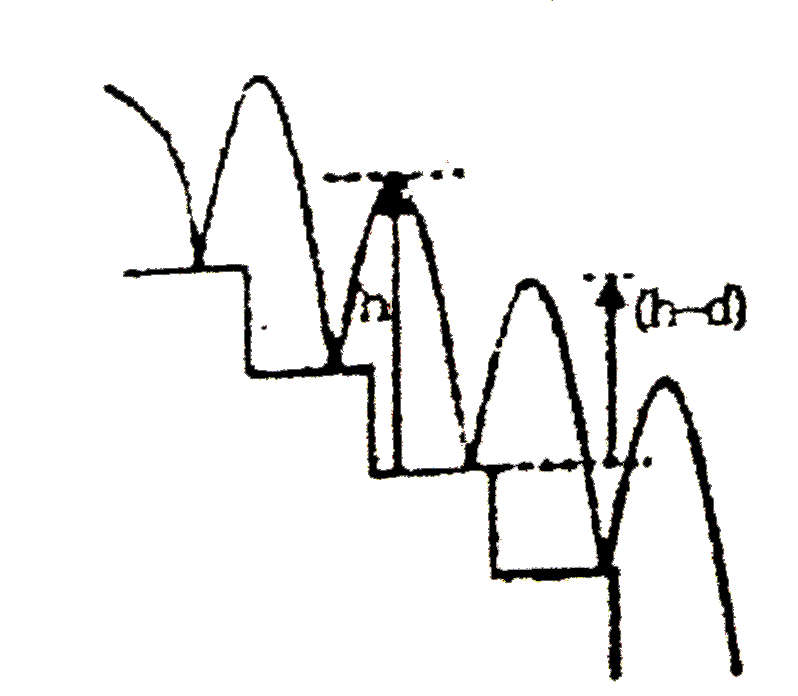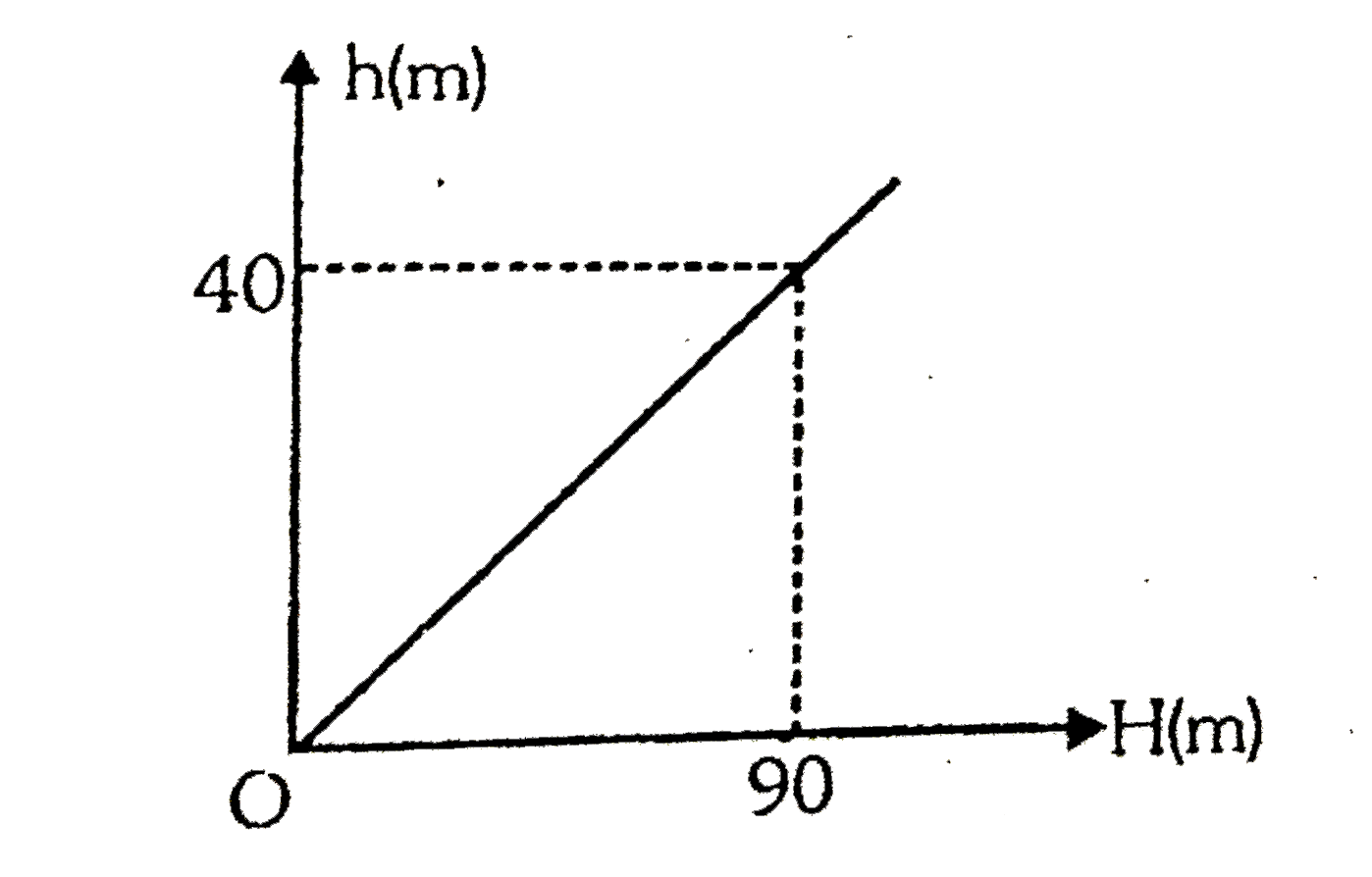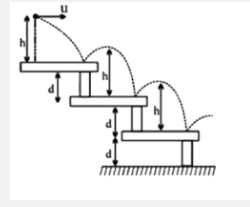A ball is bouncing down a set of stairs. The coefficient of restitution is e. The height of each step is d and the ball bounces one step at each bounce. After each bounce the ball rebounds to a height h above the next lower step. Neglect width of each step in comparison to h and assume the impacts to be effectively head on. Which of the following relative is correct ?Solution in Gujrati
hd=1−e2
hd=1−e
hd=11−e2
hd=11−e
The correct Answer is:C

√2g(h−d)=e√2gh⇒hd=11−e2
Topper's Solved these Questions
- CENTRE OF MASSBOOK - ALLEN CHAPTER - CENTRE OF MASSEXERCISE - EXERCISE-III
41 Videos
- CENTRE OF MASSBOOK - ALLEN CHAPTER - CENTRE OF MASSEXERCISE - EXERCISE-IV A
32 Videos
- CENTRE OF MASSBOOK - ALLEN CHAPTER - CENTRE OF MASSEXERCISE - EXERCISE-I
40 Videos
- BASIC MATHEMATICS USED IN PHYSICS &VECTORS BOOK - ALLEN CHAPTER - BASIC MATHEMATICS USED IN PHYSICS &VECTORS EXERCISE - EXERCISE-IV ASSERTION & REASON
11 Videos
- ELASTICITY, SURFACE TENSION AND FLUID MECHANICSBOOK - ALLEN CHAPTER - ELASTICITY, SURFACE TENSION AND FLUID MECHANICSEXERCISE - Exercise 5 B (Integer Type Questions)
3 Videos
Similar Questions
A particle of mass m, kinetic energy K and momentum p collision head on elastically with another particle of mass 2m at rest. After collision. :
Column IColumn II(A)Momentum of first particle(p)3/4p(B)Momentum of second particle(q)−K/9(C)Kinetic energy of first particle(r)−p/3(D)Kinetic energy of second particle(s)8K9None
View SolutionFig. shown a uniform square plate from identical squares at the corners can be removed. (a) Where is the centre of mass of the plate originally ? (b) Where is it after square 1 is removed ?
(c ) where is it after squares 1 and 2 are removed ? (d) Where is c.m after squares 1,2,3, are removed ?
(f) Where is c.m after all the four squares are removed ? Answer in terms of quadrants and axes.

View SolutionThe centre of mass of a non uniform rod of length L whoose mass per unit length varies as p=kx2/L, (where k is a constant and x is the distance measured form one end) is at the following distances from the same end
View SolutionAssertion: If the initial and final positions coincide, the displacement is a null vector.
Reason: A physical quantity can not be called a vector, if its magnitude is zero.
View SolutionTwo soap bubbles A and B are kept in a closed chamber where the air is maintained at pressure 8N/m2.The radii of bubbles A and B are 2cm and 4cm, respectively. Surface tension of the soap-water used to make bubbles is 0.04N/m. Find tha ratio nB/nA, where nA and nB are the number of moles of air in bubbles A and B, respectively. [Neglect the effect of gravity.]
View SolutionA ball bounce of 80% of its original height . What fraction of its mechanical energy is lost in each bounce ?
View SolutionA tennis ball bounces down a flight of stairs, striking each step in turn and rebounding to half to height of the step. The coefficient of restitution is
View SolutionA ball of mass 2kg dropped from a height H above a horizontal surface rebounds to a height h after one bounce. The graph that relates H to h is shown in figure. If the ball was dropped from an initial height of 81 m and made ten bounces, the kinetic energy of the ball immediately after the second impact with the surface was

View SolutionA ball is bouncing down a set of stairs. The coefficient of restitution is e. The height of each step is d and the ball bounces one step at each bounce. After each bounce the ball rebounds to a height h above the next lower step. Neglect width of each step in comparison to h and assume the impacts to be effectively head on. Which of the following relative is correct ?
View SolutionA staircase has each step of height h and width x. A ball strikes the centre point of a step with velocity v making an angle theta with the vertical. It rebounds and strikes the centre point of the next step. Once again it rebounds and hits the centre point of the next step and so on. Assume that there is no friction between the ball and the steps and coefficient of restitution is e. (a) Show that each time after hitting a step, the ball climbs to the same height (i.e., heights like AB and CD shown in figure are equal). (b) Find h and x.
View SolutionA ball is thrown horizontally from a height h above a staircase as shown in the figure. If the coefficient of restitution for any collision between the ball and the staircase is e, then the value of h for which the ball will bounce the same height above each step, is

View SolutionA ball is dropped from height h on the ground where co-efficient of restitution is e. After one bounce the maximum height is
View SolutionA ball is thrown horizontally from a height h above a staircase as shown in the figure. If the coefficient of restitution for any collision between the ball and the staircase is e, then the value of h for which the ball will bounce the same height above each step, is

View SolutionA small steel ball bounces on a steel plate held horizontally. On each bounce the speed of the ball arriving at the plate is reduced by a factor e (coefficient of restitution) in the rebound , so that V_("upward")=eV_("downward") If the ball is initially dropped from a height of 0.4m above the plate and if 10s later the bouncing ceases, the value of e is
View Solutionएक टेनिस की गेंद टेनिस के नेट से टकराकर उछलती है तथा पूर्व से आधी ऊँचाई तक जाती है तथा दो चरणों में उछलती है, प्रत्यास्थता गुणांक होगा
View Solution
